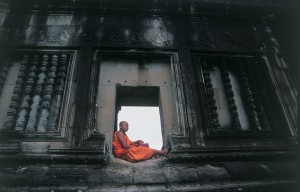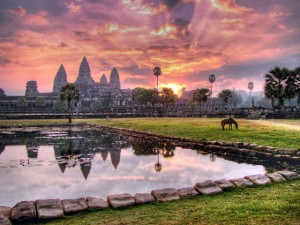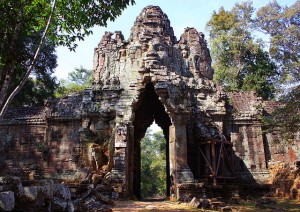Angkor Archaeological Park
Deep in the forests of Cambodia’s Siem Reap province, the elegant spires of an ancient stone city soar skyward above the sprawling complex of Angkor Archaeological Park.
Angkor is located about 20 minutes to the north, by car or motorbike, from central Siem Reap.
You need a pass to enter the Angkor complex. On sale at the front gate, you can buy 1-day ($20), 3-day ($40), or 7-day ($60) passes. The 3-day pass is valid for any 3 days within a week, while the 7-day pass is valid for any 7 days within a month. Cambodians can enter for free.
If you buy a pass in the evening, you can enter the park after 5PM to view the sunset without it counting as use of a day on your pass.
The passes are non-transferable. You will have a photograph taken and printed on your pass to make sure they are non-transferable. Regular checks for the pass are performed at almost all sites within the park, so carry your pass with you at all times.
Be sure to only buy your pass from the official Apsara Authority counters, not from other vendors, and definitely not second-hand.
Guides can be hired for about US$20 a day and are available for most major languages. Hiring a guide for at least the first day can help you get orientated to the temples and are particularly useful for finding and explaining the bas-reliefs, which can otherwise be rather overwhelming and/or difficult to understand.
Be sure and get to the temples early. The park opens at 5AM; the temples open at sunrise. There are fewer visitors early in the morning, and the sun isn’t at full force. Arriving at the temples at 8AM instead of 9AM can make all the difference in staying one step ahead of the crowds.
The main temple itself is visually, architecturally and artistically breathtaking; the pinnacle of Buddhist architecture. Its massive three tiered pyramid crowned by five beehive-like towers (stupa) rising 65 meters from ground level.
The Khmer Empire’s various capitals thrived here from the 9th to 15th centuries, while their rulers presided over an empire that stretched from Myanmar (Burma) to Vietnam.
Angkor Wat is a legacy of the might that was once the Khmer Empire, a detailed history of which has been carved into the many walls of this fortified temple. The temple is accessible by a giant stone causeway across the 200 yard wide moat, itself an incredible feat of engineering, to the west face of the Wat.
Though just one of hundreds of surviving temples and structures, the massive Angkor Wat is the most famed of all Cambodia’s temples—it appears on the nation’s flag—and it is revered for good reason. The 12th century “temple-mountain” was built as a spiritual home for the Hindu god Vishnu. The temple is an architectural triumph laden with artistic treasures like the bas-relief galleries that line many walls and tell enduring tales of Cambodian history and legend.
When you first encounter Angkor Wat the sheer size of the monuments take your breath away and the idea of exploring much of the complex may seem quite daunting.
The following is Wiki’s suggested plan to explore Angkor Wat:
Enter through the west entrance. When you reach the entry tower, walk to the right to get a glimpse of all the five towering gopuras.
Passing the tower and the libraries on both sides of the walkway, climb down the steps towards the left side and get to the water basin. You can catch a glimpse of the temple and its reflection in the water. Go past the basin and reach the left end of the temple.
Hopefully by now you would have reached the starting point of the famous bas-reliefs depicting scenes from various mythological stories and historic events. Walking from left to right you will come across scenes from battle of Ramayana, battle of Mahabharata, army of Suryavarman II, scenes from judgement by Yama (the supreme judge), churning of ocean by demons and gods to get Amrita — the nectar of immortality, Vishnu’s victory over demons, victory of Krishna over Bana and other scenes of battle between gods and demons.
In other parts of Angkor such art depicts scenes of daily life—offering scholars a precious window into the past.
Climb the steps to reach the second tier.
You can reach the third tier and the central courtyard within by climbing the steps oriented towards any of the four cardinal points. However, it is suggested that the steps on the south (right) be taken, as these have now been fitted with a handrail — particularly useful when descending.
The sight of the grand monument towering over the landscape is breath-taking at any time of day. However, to maximise the effect it is suggested that the first trip to Angkor Wat be made in optimal lighting conditions, usually around 1~2PM.
Sunrise at Angkor Wat is a also great sight to behold. Hence many tourists watch the sunrise at Angkor Wat, then explore other ruins in the morning and then return to Angkor Wat later in the afternoon.
The sun rises behind Angkor Wat and the best colors are seen just before the sun climbs into view. As the position of the sun as it rises varies according to the time of year, do position yourself accordingly. For example, in November-December time when you are facing Angkor Wat, the sun rises on your right hand side. Hence grab a place to the extreme left of the entry tower to see the sunrise.
Sunset at Angkor Wat is best viewed either on the top tier or outside the main temple structure.
The Famous Bayon Temple is the spectacular central temple of the ancient city of Angkor Thom. Dating from the 12th century, this complex is located just to the north of the famous Angkor Wat. Learn more by clicking here.
The Tower Temple of Baphon
Located to the northwest of the Bayon, the Baphuon is supposed to represent Mount Meru (sacred to Hinduism), and was one of the largest and grandest structures in Angkor. Built into the western face of the Baphuon is a giant reclining Buddha, added in the 16th century after the region converted from Hinduism to Buddhism.
Archaeologists had dismantled the Baphuon to perform renovation when they were interrupted by the civil war; the records for piecing the temple back together were subsequently lost or destroyed. Today it is undergoing painstaking reconstruction work, so visitors can only walk across the long terrace leading up to the main structure and around the outside base. Completion is estimated for 2010.
The Bayon and Baphuon Temples form only part of what was formerly the giant city of Angkor Thom, once thought to hold a population of one million.
In addition to the Bayon and Baphuon temples, the ancient city of Angkor Thom holds a number of other sites of interest:
The Terrace of Elephant
Terrace of the Leper King
Five Gates of Angkor Thom
Angkor Thom has 5 entrance gates, one at each ordinal compass point and the Victory Gate in the east wall. The western and the northern gate are free from tourists, and climatic. Each of the gates is topped by the face of Avalokitesvara. There is a path on top of the walls, and one along the outside wall, that can be followed to walk from gate to gate. The total walk is around 13km, about 3.5 hours long.
Phnom Bakheng
The first temple-mountain constructed in Angkor, with a commanding hilltop location.
Extremely popular (and crowded) spot for sunsets: allow half an hour for the sweaty hike to the top, and leave early or bring a flashlight for the way back.
The final climb to the top of the temple is steep and dangerous at dark. Elephants will carry you to the hilltop for $20 per person, but you still have to climb the temple stairs on your own. Note that the sun does not set over Angkor if seen from here, and any visible temples are in fact quite far away.
**Please note that you are NOT allowed to climb Phnom Bakheng after 17.30 – hence make sure you arrive earlier.
An elephant ride back down the hill will cost $15.
Another great way to see the sites of the Angkor Archeological Park is by Helicopter.
Helicopter flights are a great way of seeing Angkor Archaeological Park. You can also visit outlying temples like Banteay Chhmar, Boeng Mealea, Koh Ker, Rolous Group, Phnom Bok & Tonle Sap floating village.
Sokha Helicopters have prices starting from US$110 per person for the basic Angkor Wat, Prasart Kravan, Bat Chum, Sras Srang, Pre Rup, Eastern Mebon & Ta Som 12 minutes tour. Flights depart daily next to the Sokha Yellow Balloon on the road from Siem Reap International Airport to Angkor Wat main entrance. Bookings essential and can be made through hotels or travel/tour agents or direct on +855 12 449 555.
By traveling by helicopter you learn to appreciate that Angkor is as much about water as it is about stone. The site boasts an enormous system of artificial canals, dikes, and reservoirs, the largest of which (West Baray) is 5 miles (8 kilometers) long and 1.5 miles (2.4 kilometers) wide. These incredible feats of engineering form an integral part of an overall site design that remains faithful to religious symbolism. Moats, for example, simulate the oceans surrounding Mount Meru, the home of Hindu gods.
But these massive works also served a practical purpose by skillfully harnessing river and rainwater to quench the thirst of some 750,000 residents in the world’s largest preindustrial city. That water also irrigated wealth-producing crops like rice, which served the Khmer as currency.
Some scholars speculate that the downfall of this elaborate water system led to the end of Angkor. A series of weak monsoons and/or the collapse of the water works due to environmental issues, like deforestation, which drove destructive floods and choked the system with sediment, might have tipped the movement of power toward Phnom Penh.
Even after its glory days had passed, Angkor remained popular with Buddhist pilgrims who journeyed from across Southeast Asia and beyond. Today the site also draws secular travelers—almost a million a year.
When Angkor was named a World Heritage site in 1992 it was also added to the List of World Heritage in Danger; the incomparable site was threatened by pillaging, plagued by illegal excavations, and even dotted with land mines. In 1993 UNESCO launched a major campaign to restore and safeguard Angkor. Thanks to a textbook case of international cooperation Angkor rebounded so dramatically that it was removed from the List of World Heritage in Danger in 2004.
UNESCO continues to be a part of Angkor’s future, working with the Cambodian authorities to ensure that tourism access and development do not compromise this great cultural treasure.
View Larger Map


